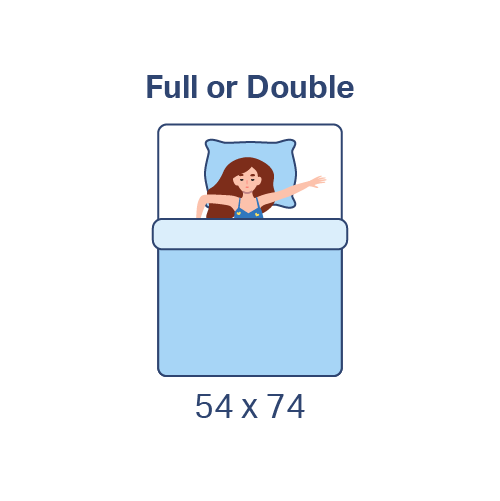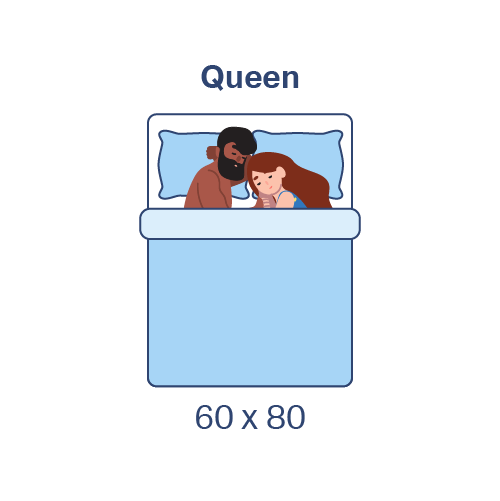Purchasing a brand-new bed can be quite costly, especially if you opt for a larger bed that surpasses your actual needs. After all, a bigger mattress necessitates a larger bed frame, along with larger sheets and blankets. The cumulative expenses associated with these items can significantly inflate the total cost of a bed.
A widely chosen option among many individual sleepers is a full size bed, also referred to as a double bed. It is wider than a twin bed, yet narrower and shorter than a queen bed. This type of bed is popular due to its affordability and space efficiency, making it particularly suitable for smaller bedrooms. Moreover, a full bed can comfortably accommodate either two small children in a shared room or be utilized in a guest bedroom to maximize available space.
In order to assist you in determining whether a full size bed is the ideal choice for you, we will thoroughly examine the most common full size bed dimensions and compare them to other standard mattress sizes.

A full size bed, also known as a double bed, has measurements of 54 inches in width by 75 inches in length. Full size mattresses are available in a variety of thicknesses, typically ranging from 8 to 14 inches. While thicker mattresses can offer enhanced comfort and durability, they may require sheets with deep pockets to properly fit around their taller edges.
Full size beds are frequently employed in smaller bedrooms that are unable to accommodate larger beds. They provide ample space for a solitary sleeper who desires a bit more room on each side compared to what a twin mattress offers. Alternatively, a full bed can comfortably accommodate two children or a parent and a young child.
There are a total of six standard mattress sizes, ranging from twin to California king. Although the measurements generally remain consistent, slight discrepancies in mattress sizing between different manufacturers are not uncommon. When purchasing a mattress, it is advisable to review the manufacturer’s dimensions to ensure a proper fit within your bed frame.
Twin, twin XL, and full mattresses are typically designed for single sleepers. Conversely, queen, king, and California king mattresses are typically able to accommodate two or more individuals.
Mattress SizeDimensions (Width x Length)
Twin: 38” x 75”
Twin XL: 38” x 80”
Full: 54” x 74”
Queen: 60” x 80”
King: 76” x 80”
California King: 72” x 84”
Queen size beds are six inches wider and five inches longer than full size mattresses. The extra space provided by queen beds enables two adults to sleep comfortably side by side, making them a popular choice among couples.
A full size bed presents several advantages, such as occupying less room within a given space. This can make a noticeable difference within bedrooms that possess limited square footage. Additionally, due to their smaller size, full mattresses generally come at lower price points compared to queen size mattresses.

For individuals who frequently move residences, another benefit of full size beds is their greater ease of transportation. Maneuvering queen mattresses up staircases and through narrow doorways can be arduous, whereas the smaller dimensions of a full bed make it more convenient to move.
Selecting the right mattress involves considering the various pros and cons associated with each size. Factors including the number of sleepers, mattress height, sleep position, bedroom size, and budget all play a role in this decision-making process. If you find yourself with limited bedroom space or a modest budget, a full bed may be the optimal mattress option for you.
When it comes to selecting a mattress, one key factor to consider is whether you share your bed with a partner or a furry companion. A full-sized bed, measuring 54 inches in width, offers ample space for a single person to stretch out comfortably or for a cozy slumber with a small pet. This size can also be a suitable choice for adults who share a bed with a child or for two children sharing the same sleeping space.
For couples seeking a bed-sharing experience, a queen-sized mattress is the preferred option. With an additional six inches in width compared to a full bed, it offers a generous sleeping surface that allows each individual to have their own space for a comfortable rest.
Your height is another factor to consider when determining the ideal mattress size for you. If you are six feet or taller, you may find that your legs extend beyond the foot of a twin or full-size bed, given their length of 75 inches. Twin XL, queen, and king mattresses, on the other hand, provide 80 inches of length, while a California king offers 84 inches, catering to the needs of taller sleepers.
Conversely, if you are on the shorter side, having excessive space around you may not be desirable. A twin or full-sized bed could provide a more snug and cozy environment that better suits your body shape compared to a larger mattress.
Your sleeping position also plays a role in deciding the most comfortable mattress size for you. Back or stomach sleepers tend to require more length to stretch out fully during the night, making a longer bed like a queen or king a suitable choice. On the other hand, if you sleep on your side and curl your legs, a twin or full-sized bed might offer enough length for your needs.
The dimensions of your bedroom should also be taken into account. Ideally, there should be a few feet of space on both sides as well as at the foot of the bed for easy movement. To comfortably accommodate a full bed and other bedroom furniture, your room should measure approximately 120 square feet. Full beds are particularly well-suited for guest rooms, as they are more cost-effective than queen-sized beds and occupy less space. This allows the room to serve a dual purpose, such as functioning as a home office or storage area.
Furthermore, the shape of your room influences how well the bed integrates into the space. In narrow bedrooms, a twin, twin XL, or full-sized bed tends to be the optimal choice, while a queen or king mattress can help fill out larger rooms.
In terms of affordability, twin, twin XL, and full-sized beds are generally more budget-friendly compared to queen, king, and California king mattresses. Larger sizes also often entail higher costs for accessories like pillows, sheets, and bed frames. By opting for a full-sized bed instead of a queen, you can easily save money on the overall cost of your bed and bedding, making it an excellent option for those mindful of their expenses.


